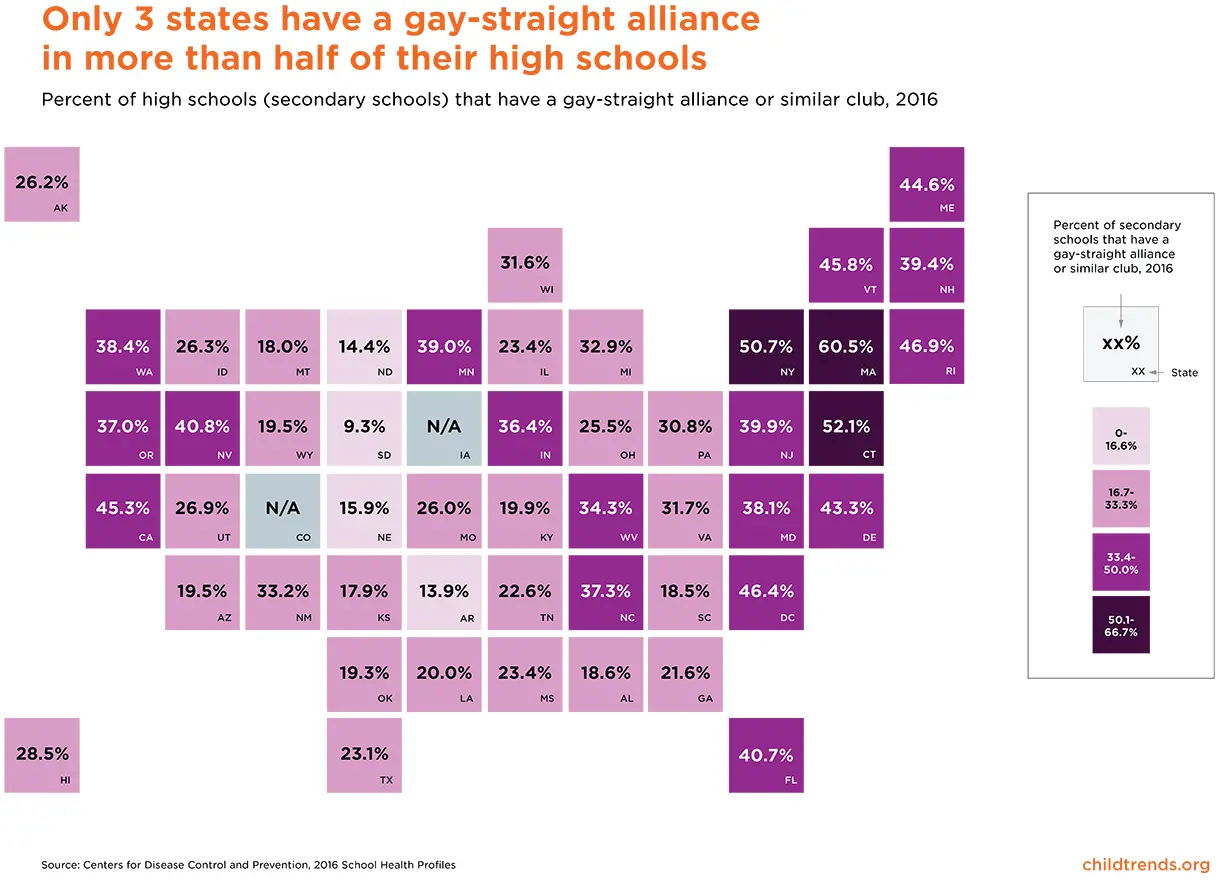Only 3 states have a gay-straight alliance in more than half of their high schools
This blog has been updated here to reflect the most recent data and new analysis.
In 45 states and the District of Columbia, less than half of all high schools report having a gay-straight alliance (also known as a genders and sexualities alliance, or GSA), according to 2016 data from the Centers for Disease Control and Prevention. Among the 48 states (as well as the District of Columbia) that provide data, only three states (New York, Connecticut, and Massachusetts) can claim that more than half of their high schools have a GSA. Massachusetts has the highest percentage of high schools (60.5%) with a GSA, while South Dakota has the lowest (9.3%). Less than 16 percent of high schools in four states (including South Dakota) have a GSA. In 25 states, 17.9 percent to roughly one-third of high schools have a GSA; in an additional 16 states and the District of Columbia, GSAs can be found in roughly one-third to 46.9 percent of secondary schools.

GSAs are school clubs led by students, with support from faculty sponsors, in which students can talk, learn about, and educate others on sexual orientation, gender identity, and some of the issues that surround them. There are currently at least 4,000 GSAs across the country. Organizations such as GSA Network and GLSEN have programs to register GSAs and offer resources for students and faculty advisors.
In a recent review of LGBT-focused school policies and practices, researchers noted that, of all reviewed interventions, GSAs are supported by the most consistent evidence showing that they improve school climate and academic outcomes for lesbian, gay, bisexual, transgender, and queer/questioning (LGBTQ) youth. Specifically, the researchers identified several studies that documented reduced homophobic victimization of lesbian, gay, and bisexual students in schools with GSAs. LGBTQ youth who participate in GSAs report that the clubs are a source of community, a gateway to LGBTQ-friendly resources, and a marker of safety.
There is also evidence that the presence of GSAs is associated with benefits for all students regardless of their sexual orientation or gender identity—including youth who do not identify as LGBTQ and those who do not participate in the GSA. For example, one study found reduced substance abuse, suicide attempts, and risky sexual behavior among youth in schools with GSAs—with the greatest effects seen among LGBTQ students.
Less research on GSAs has focused on the specific experiences of LGBTQ youth of color. A recent survey of GSA faculty advisors at 33 high schools—nearly all of them white—found that advisors felt less equipped to address the needs of LGBTQ youth of color than those of white LGBTQ youth. This finding suggests that youth of color may not experience the benefits of GSAs in the same way as their white peers. Given that LGBTQ students of color often experience racism in addition to discrimination related to their sexual and/or gender identity, this represents a critical gap in how the field understands the effects of GSAs.
© Copyright 2024 ChildTrendsPrivacy Statement
Newsletter SignupLinkedInThreadsYouTube